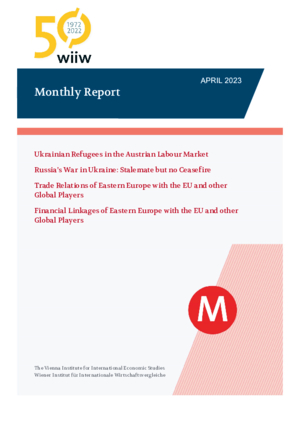Monthly Report No. 4/2023
Vasily Astrov, Olga Pindyuk, Maryna Tverdostup and Sergey Utkin
wiiw Monthly Report No. 4, April 2023
53 pages including 2 Tables and 33 Figures
- Chart of the Month: Ukrainian refugees in the Austrian labour market
by Maryna Tverdostup
- Opinion Corner: Russia’s war in Ukraine: Stalemate but no ceasefire
by Sergey Utkin
A ‘war of attrition’ is among the most common descriptions used for the ongoing military stand-off in Ukraine. Both sides are sticking to their territorial ambitions, which are inherently irreconcilable. The widespread analytical conclusions about the future are based on extrapolation from the current situation. And while history rarely develops in a linear way for long, there is indeed good reason to believe that a potential defining moment in the war will come no earlier than next year, which means more casualties and destruction ahead.
- Trade relations of Eastern Europe with the EU and other global players
by Vasily Astrov
For most East European countries, the EU is far and away their most important trading partner – although in some post-Soviet countries the EU has been losing out to Russia. The EU is also far more ambitious than other global players with respect to trade integration arrangements with the region, and the exports of East European countries to the EU are generally more advanced than are their exports to Russia. However, the differences in trade complementarity on the export and on the import side mean that the benefits of trade integration tend to be asymmetric: the EU emerges as the main beneficiary, while the competitiveness of East European economies often does not improve fundamentally.
- Financial linkages of Eastern Europe with the EU and other global players
by Olga Pindyuk
The EU remains the main source of capital for Eastern Europe, in terms of both FDI and banking sector domination. Besides, the bloc is an important source of budgetary support for the region and has provided unprecedented assistance to Ukraine since the start of the war. However, China’s influence in the region has also been growing, especially in the Western Balkans and Turkey, largely within the framework of the Belt and Road Initiative.
- Monthly and quarterly statistics for Central, East and Southeast Europe
Reference to wiiw databases: wiiw Annual Database, wiiw Monthly Database
Keywords: refugees, labour market, Russia’s war in Ukraine, foreign policy, prospects for ceasefire, trade importance, commodity structure of trade, free trade agreements, trade complementarity, foreign direct investment, Belt and Road Initiative, banking sector, budget support
Countries covered: Albania, Austria, Belgium, Bosnia and Herzegovina, Bulgaria, China, Croatia, Cyprus, Czechia, Denmark, Estonia, EU, Finland, France, Germany, Greece, Hungary, Ireland, Italy, Kosovo, Latvia, Lithuania, Luxembourg, Malta, Montenegro, Netherlands, North Macedonia, Poland, Portugal, Romania, Russia, Serbia, Slovakia, Slovenia, Spain, Sweden, Turkey, Ukraine, US, Western Balkans, EU Eastern Partnership countries, Armenia, Azerbaijan, Belarus, Georgia, Moldova
Research Areas: Macroeconomic Analysis and Policy, Labour, Migration and Income Distribution, International Trade, Competitiveness and FDI
